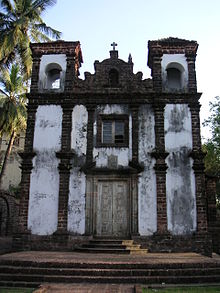- Christianity in Goa
-
Christianity is the second largest religious grouping in Goa, India. According to the 2001 census, 27% of the population are Christian, while 66% are Hindu.[1] The Christian population is "almost entirely Catholic,"[2] and Goan Catholics form a significant ethnoreligious group.
Contents
History
Chapel of St. Catherine, built in Old Goa during the Portuguese occupation. It should not to be confused with the Cathedral of Santa Catarina, also in Old Goa.
Portuguese occupation
See also: Christianisation of GoaAfter the Portuguese Conquest of Goa in 1510 and it's subsequent occupation by Portugal, Goa's indigenous population underwent a large scale conversion to Christianity.
The state of Goa became the center of Christianization in the east.[3] The evangelization activities of Goa was divided in 1555 by the Portuguese viceroy of Goa, Pedro Mascarenhas. He alloted Bardez to the Franciscans, Tiswadi to the Dominicans, and Salcette, together with fifteen southeastern villages of Tiswadi, including Chorao and Divar, to the Jesuits.[4]
After conversion, locals were usually granted Portuguese citizenship.[5] The rapid rise of converts in Goa has been described as mostly the result of Portuguese economic and political control over the Hindus, who were vassals of the Portuguese crown.[6]
The process of Christianisation was simultaneously accompanied by "Lusitanisation," as the Christian converts typically assumed a Portuguese veneer. This was most visible by the discarding of old Hindu names for new Christian Portuguese names. Converts usually adopted the surnames of the Portuguese priest, governor, soldier or layman who stood as godfather for their baptism ceremony. For instance, the Boletim do Instituto Vasco da Gama lists the new names of some of the prominent ganvkars (Konkani: Freeholders). Rama Prabhu, the son of Dado Vithal Prabhu from Benaulim, Salcette became Francisco Fernandes, while Mahabal Pai, the son of Nara Pai, became Manuel Fernandes in 1596. Mahabal Kamati of Curtorim became Aleisco Menezes in 1607, while Chandrappa Naik of Gandaulim became António Dias in 1632. In 1595, Vittu Prabhu became Irmao de diago Soares and the son of Raulu Kamat became Manuel Pinto in Aldona, Bardez. Ram Kamat of Punola became Duarte Lobo in 1601, while Tados Irmaose of Anjuna became João de Souza in 1658.[7] However, the converted Hindus retained their mother tongue (which in most cases, was Konkani) and caste status, even after becoming Christian. Based on their previous caste affiliations, the new converts were usually lumped into their new respective Catholic castes.[8]
 A typical white Sant Khuris (Holy Cross), of a Goan Catholic family, constructed using olden-style Portuguese architecture.
A typical white Sant Khuris (Holy Cross), of a Goan Catholic family, constructed using olden-style Portuguese architecture.
The converts from the priestly Brahmin class were Bamonns (Konkani word for Brahmins). All Brahmin sub-castes such as the Goud Saraswat Brahmins, Padyes, the Daivadnyas and some merchants, were lumped into the Christian caste of Bamonn. These accounted for the largest group of converts. The converts from the Kshatriya caste who formed the second largest group were Chardos (Konkani word for Kshatriya); and converts from the labour class Shudra which formed the third largest group became Sudirs (Konkani word for Shudra).[8]
The Portuguese demolished almost all the temples from the old-conquests.The temple art, along with its literature was destroyed, as a part of the Christanisation initiatives by the Portuguese. [9]
Goa inquisition
Main article: Goa InquisitionIn 1560, the Inquisition established an office in Goa. It was finally abolished in 1812.
Modern times
Since 1851, the Christian population of Goa has been facing a continual decline. As a result, the percentage of Christian population (once a majority) has shifted in favor of the Hindus. As per the data available, Christians constituted 64% and Hindus 35% in 1851 census.[10] Currently, Christians constitute 27% and Hindus 66% of the population of Goa.[1]
As of 2001, the Goan Konkani New Testament was being retranslated. According to Operation World, the old translation is "little understood today."[2]
Roman Catholicism
The Archbishop of the Roman Catholic Archdiocese of Goa and Daman carries the title Patriarch of the East Indies.
Other churches
There is at least one Methodist church in Goa.[11] Goa is part of the Diocese of Kolhapur of the Church of North India.
See also
References
- ^ a b "Population by religious communities". Census department of India. http://www.censusindia.gov.in/Census_Data_2001/Census_data_finder/C_Series/Population_by_religious_communities.htm. Retrieved 10 March 2010.
- ^ a b Patrick Johnstone and Jason Mandryk, Operation World: 21st Century Edition (Paternoster, 2001), 322.
- ^ Conversions and citizenry: Goa under Portugal 1510-1610, Délio de Mendonça, Concept Publishing Company, 2002, p.67
- ^ Vide, Meersman, Fr. Achilles, O.F.M. "The Ancient Franciscan Provinces In India, 1971, Bangalore", p.107
- ^ Pidgins and Creoles: References survey, John A. Holm, Cambridge University Press, 1989, p.286
- ^ Conversions and citizenry: Goa under Portugal 1510-1610, Délio de Mendonça, Concept Publishing Company, 2002, p.397
- ^ History of the Dakshinatya Saraswats, Venkataraya Narayan Kudva, Samyukta Gowda Saraswata Sabha, 1972, p. 359
- ^ a b Land and people of Indian states and union territories, Gopal K. Bhargava, Gopal K.; S. C. Bhatt., p. 39.
- ^ Goa and Portugal: their cultural links. Concept Publishing Company,. 1997. pp. 319(refer page:58). ISBN 8170226597, 9788170226598.
- ^ Goa Through Ages: An economic history by Teotonio R De Souza
- ^ http://www.goa2u.com/churches.htm
Categories:- Christianity in Goa
- Christianity in India by region
- Religion in Goa
Wikimedia Foundation. 2010.

